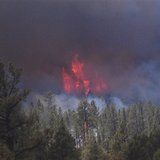
The virtually unchecked wildfire is fueling experts' predictions that this is a preview of things to come as states across the West contend with a dangerous recipe of wind, low humidity and tinder-dry fuels.
The Whitewater-Baldy blaze has charred more than 190,000 acres, or nearly 300 square miles, in Gila National Forest and has become the largest wildfire burning in the country.
Gov. Susana Martinez viewed the fire from a New Mexico National Guard helicopter Thursday and saw the thick smoke shrouding some of the steep canyons that are inaccessible to firefighters. She described the terrain as "impossible," saying there was no way for firefighters to directly attack the flames in the rugged areas of wilderness.
"It's going to keep going up," she said of the acreage burned. "Be prepared for that."
Along the fire's northern edge, Martinez spotted crews doing burnout operations designed to slow the erratic blaze, which has surpassed last year's Las Conchas fire as the state's largest ever. That fire charred 156,593 acres and threatened the Los Alamos National Laboratory, the nation's premier nuclear facility.
From the air, Martinez could see the blanket of smoke stretching for miles. She used words like daunting and enormous, fitting since fire managers said the blaze could smolder until the region gets significant rainfall during the summer monsoon season.
More than 1,200 firefighters are at the massive blaze near the Arizona border. It has destroyed a dozen cabins and eight outbuildings, fire information officer Iris Estes said.
Experts say persistent drought, climate change and shifts in land use and firefighting strategies mean other western states likely will see similar giant fires this season.
"We've been in a long drought cycle for the last 20 years, and conditions now are great for these type of fires," said Steve Pyne, author of Tending Fire: Coping with America's Wildland Fires and a life science professor at Arizona State University. "Everything is in line."
Agencies in New Mexico, Colorado and Arizona are bracing for the worst. Many counties have established emergency telephone and email notification systems to warn of wildfires, and most states have enlisted crews from other jurisdictions to be ready when the big ones come.
"It's highly likely that these fires are going to get so big that states are going to need outside resources to fight them," said Jeremy Sullens, a wildland fire analyst at the National Interagency Fire Center.
According to the National Weather Service, a dry climate is expected to prolong drought conditions across the Great Basin and central Rockies during the fire season. Large portions of Nevada, Arizona, Utah, Colorado and New Mexico will remain under severe drought conditions.
"We're transitioning from La Nina to El Nino, so we have no guidance to what's going to happen, like if we will get more rain or less rain," said Ed Polasko, a weather service meteorologist.
A lack of moisture means fewer fuels to burn in some areas, but unburned vegetation elsewhere could pose a problem since many states received no sustained snow or rain this winter and spring.
That's what happened in New Mexico's Gila Wilderness, where a lack of snow failed to push down grass, which worsened the fire danger, Sullens said.
Typically, fires in the area don't cross the middle fork of the Gila River, said Danny Montoya, an operations section chief with the Southwest Incident Management Team.
"This year, it did get across," Montoya said. "We're getting humidity levels during the day about 2 to 3 percent. Normally, during summer you'd see 5 to 12 percent."
Officials closed the Gila Cliff Dwellings National Monument on Thursday due to smoke generated from the fire. The National Park Service said the closure would remain in effect until conditions improve.
The blaze is 5 percent contained, but fire managers expect that to jump as crews bolstered lines on the northern end. Scars from previous burns were also helping to slow the flames on the southeastern flank.
"We're continuing with burnout operations and we've been helped with a slight rise in humidity and decreased winds," Estes said.
Another reason states in the West will see more massive fires this season is because, coupled with drought and dry climate, crews have experienced changes in firefighting strategies and agencies have changed some policies in fighting wildfires in isolated areas, Pyne said.
"In the last 20 years or so, agencies have generally been reluctant to put firefighters at risk in remote areas," Pyne said. "It wasn't like that decades ago."
Instead, he said agencies have focused attention on burnout operations until conditions are safe to begin containment.
Not that those practices and the large fires are bad things, Pyne said. For example, he said the Gila Wilderness has been a target for controlled burns.
"So maybe," Pyne said, "this is how it's supposed to happen."



Reader Comments
to our Newsletter